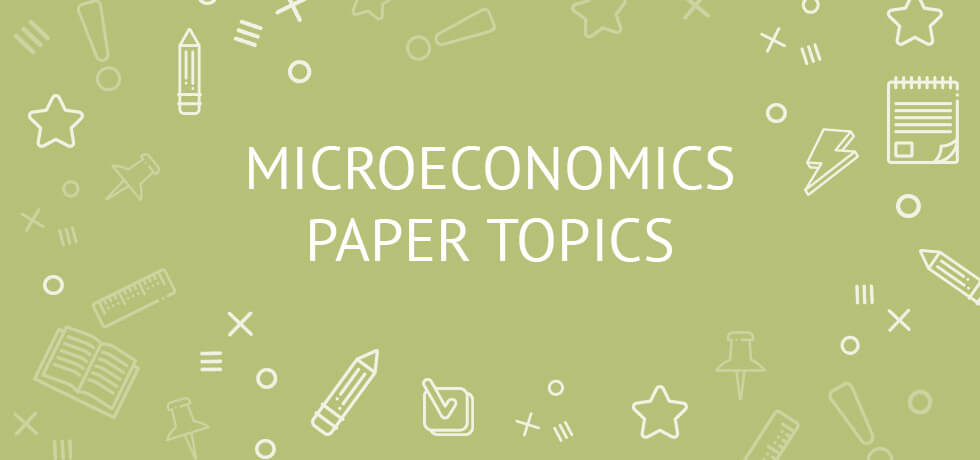Microeconomics Paper Topics
One of the hardest things about writing a paper is finding a great topic to write about. Finding the right question is the most vital step in the writing process, and a poor decision can be disastrous. Choosing wisely will mean you will choose a topic you enjoy and know well which will make the writing process a lot easier. If you rush into it, you can make a poor decision, and it will be harder work. You could struggle to find the research that helps your rogerian argument example, and you could also be second-guessing your own knowledge.
It is vital to invest time in researching and selecting the topic that suits your skills and knowledge best. Spending time on formulating, research and crafting the right question might seem like a waste of time, but it is an investment that will save you effort in the long run. Keep in mind text structure as well, conclusion paragraph outline may be as important as topic choice. This article has gathered a list of common topics and areas that micro-economic papers focus on. Some of these topics have a broad scope, whereas other topics are narrow and focused.
Important Areas of Research
Microeconomics is an area of economic science that is based on a robust body of scientific research. This research has formulated methods that helps economists predict economic tendencies by knowing how the market will react when certain individuals make a purchasing decision. It should be noted that this is a predictive model that only helps indicate possible changes on the market due to economic stimulus and as such the actual reactions may differ to those predicted.

Here is a list of general topics that a micro-economics paper question can be formulated around:
- The balancing of supply and demand
- Elasticity. This is to see how fast one variable response to a change in another variable.
- Consumer Demand Theory. How consumers can reconcile the balance between the need of buying a product or a service against its cost.
- The theory of production. This studies how inputs are transformed into outputs.
- Production costs
- Perfect competition
- Monopoly and how the existence of a single dominant supplier for a commodity affects the marketplace, and consumer demand theory
- The structure of a market and the system that comprises it.
- Game theory
- The economics of labor
- Economics of information
- An argumentative essay on the microeconomic market structure
- Opportunity costs.
- Discuss the conditions required for a practical implementation of the Micro-economic model include the interaction between natural, industrial and household.
- What ecological problems are the US and Europe facing due to their planned economies?
Micro-economic essay questions focused on Supply and Demand:
- What is the impact that supply and demand have on pricing?
- How are supply and demand is influenced by the labor market? What role does the Labor union play in this?
- How impact does the different types of market structure, have on supply and demand.
Micro-economic essay questions focused on Ecology and Nature:
- How do seasonal fluctuations affect the economy?
- An investigation into the demand for clean energy and how it is being supplied.
- How is the economy affected by the natural world?
- Choose an industry and discuss the impact ecology had its location
- What are the profits and loss of relocating from a poor to a better ecology?
- How do the modern ecological problems correlate to the economy?
- How do companies deal with ecology under market and planned economies?
- Research into how selected areas are assimilated into business.
- What safeguards can help to prevent pollution and the micro-economic impact it has?
- How would you decrease the environmental influence of a small business?
- Discuss the economic struggle a business faces to maximize the use of natural resources and the reasons why it should?
- Is nature the biggest victim of industrialization? How does the destruction of nature affect economics?
Micro-economic essay questions focused on Healthcare:
- What are the main traits of a private healthcare care system?
- Discuss the pros and cons of a private health care system?
- How does healthcare profits correlate with taxation?
- What are the costs of a healthcare system and how do they affect taxes?
Micro-economic essay questions focused on Business, SMB, and Manufacturing:
- What are the difficulties a new business will face due to the current market conditions? (Can be narrowed further to industry-specific business.)
- What is the Law of Diminishing Returns and how do you combat its influence on input?
- How do you improve the profitability of a small business?
- In what ways does local manufacturing impact society?
- What effect does purchasing local produce have on the economy?
- What are the key elements for a successful business?
- Why is having a positive work atmosphere vital for a successful business?
- What can a business do to survive an economic crisis?
- How do smaller companies compete with bigger rivals?
- Conduct a case study on a business that forced to close and analyze alternatives.
- Investigate and document local trends in a local custom to expand or open a business.
- How does a business benefit from a no-sale policy?
- Select an industry and discuss the effects a recession will have on it.
- How would you minimize both the risks and cost of an expanding business?
- Discuss and analyze the characteristics of a strong leader in business.
- How do you prevent a small business from going bankrupt?
- What are the benefits of crowdfunding? What tendencies do you predict for the future of crowdfunding?
- What are the benefits of creativity and how does it help a company succeed?
Micro-economic essay questions focused on Social Media, PR, and Advertising:
- How does advertising impact purchasing decisions?
- How is advertising used within Microeconomics? What are its benefits?
- What are the odds of a business successful navigating through a quality related scandal?
- What role does social media marketing play in stimulating supply?
- What are the advertising problems that can lead to the closure of a company?
Micro-economic essay questions focused on Good, Pricing, and Purchasing Power:
- How does the purchasing ability of consumers influence the pricing system deployed by businesses?
- What is a Veblen good? Discuss what products the consumers buy for the pride of owning it in addition to its value.
- How do Cartels manipulate the price of oil and gas?
- Discuss Pricing versus salary regarding the minimum wage increases.
This is but a small sample of the most common topics that are researched and discussed in micro-economics. We hope that by reading this list, we have given you an idea where to focus your research and studies. You can more examples like sociology papers topics and many others while researching this blog. This list should be used more as a guide to finding a question or area of study as the best questions are those tailored to the essay writer.
The topics covered in this list are not exhaustive which means there is a wide range of more exclusive areas that need to be researched. As the other areas need more research, we'd encourage you to investigate and research other areas. Who knows you might write a career-defining paper.
A sample essay for Microeconomics
Here is a short sample essay to get your economic muses flowing.
Is nature the biggest victim of industrialization? How does the destruction of nature affect economics?The U.S economy has grown by one hundred percent between 1970 and 2012, however; the cost of this profit has been the server pollution of the natural environment. Despite the fact that there has been a large number of anti-pollution policies introduced by the United States, they have only resulted in minimal reductions. It has been estimated that carbon dioxide emission has only decreased by 12% between 2007 and 2012. Carbon Dioxide is just a single pollutant among a plethora of toxins to the environment. This indicated that pollution caused by business remains a troubling and major problem.
Microeconomics classifies pollution as an externality. An externality is defined as an act that affects third-party individuals who are not involved in the action. The effect can have either positive or negative consequence. For example, if an individual resides in an area where live music festivals are held, but they don’t attend or partake in the event they are considered an externality as they can hear the music. Depending on their viewpoint this can a positive or negative experience. Pollution, however, can only be considered a negative externality due to its detrimental effects on humans, animals, and plants.
The demand for commodities has stimulated production rates to increase and created an increase in the toxic by-products that are harmful to the environment. The toxic waste products are passed on to society. Only by lowering the number of commodities that industry manufacture can we hope to lower the continuation levels to the natural environment. A trend that will not happen in our current consumer-driven economy.
To combat this disturbing trend, economists have argued that the cost of production should include the costs of pollution. These costs are too numerous to list in full but include: - The impact pollution has on human health, the effect it has on property value, the effect it has on recreational events, the effect it has on wildlife habitats. Here is an example of how this cost consideration would work:
A company that manufacturers freezers at a production cost of $600 per unit. To produce a unit without polluting the environment, it would cost the manufacturers an additional $100 per unit. A number of units it could produce would go down due to the increase in expense. The sales price of the product would also increase significantly as the economically friendly model would have greater production cost to recover. A customer comparing products that have the technical specifications where the only difference is one is eco-friendly would usually opt for the cheaper option – the freezer that damaged the environment. This means eco-friendly companies cannot produce the same number or compete effectively and will return much lower profits.
To reduce the pollution, there has to be a significant change in consumer behavior where eco-friendly products are more desirable; or, governmental legislation has to be put into place, where environmental damage leads to a greater cost than producing a clean product. It is only through such actions that the economic needs will shift to protect the environment from harm.





